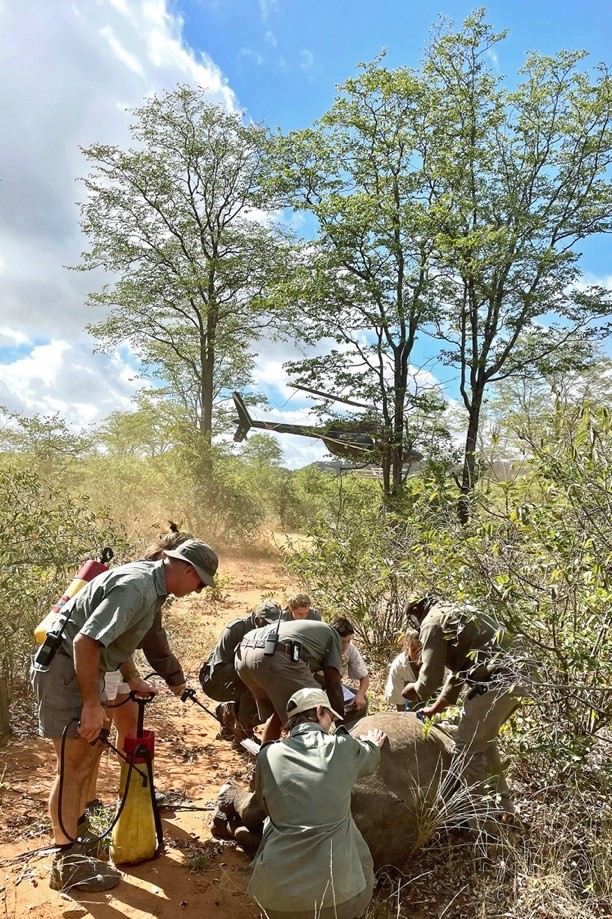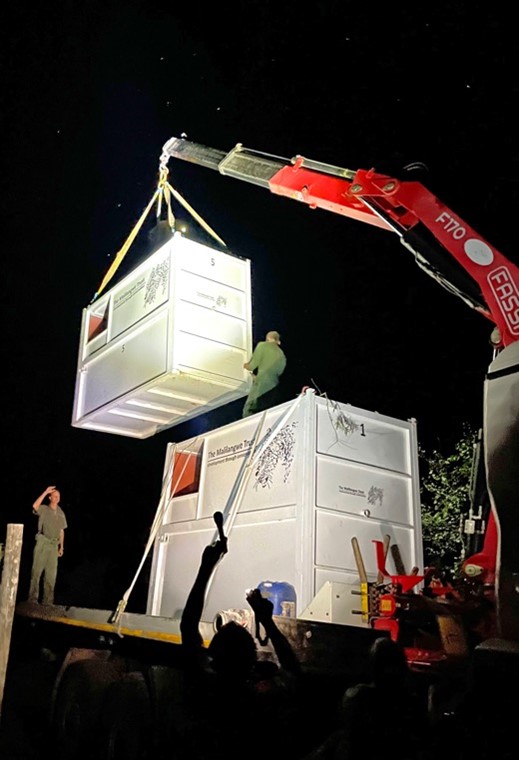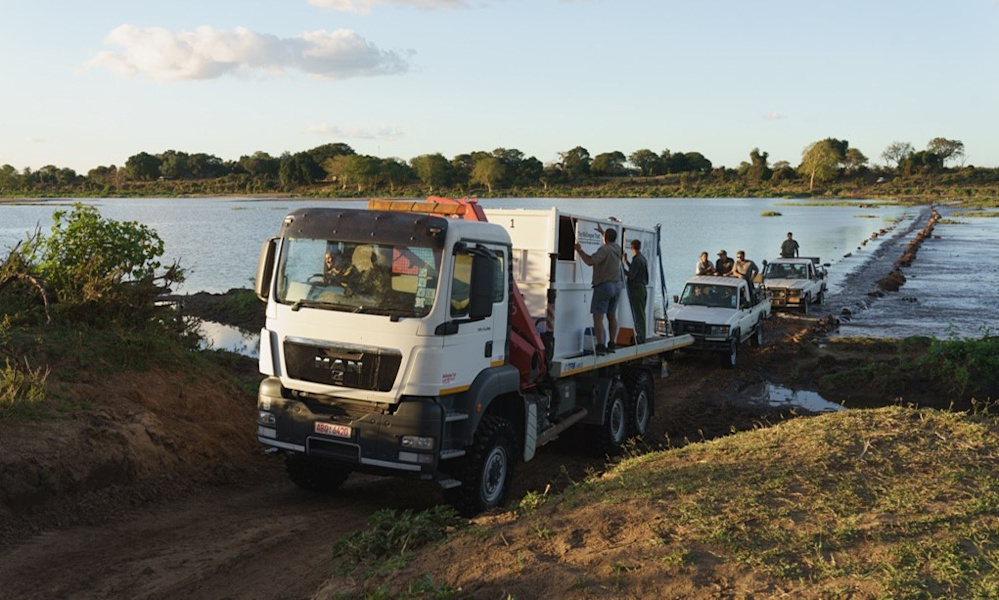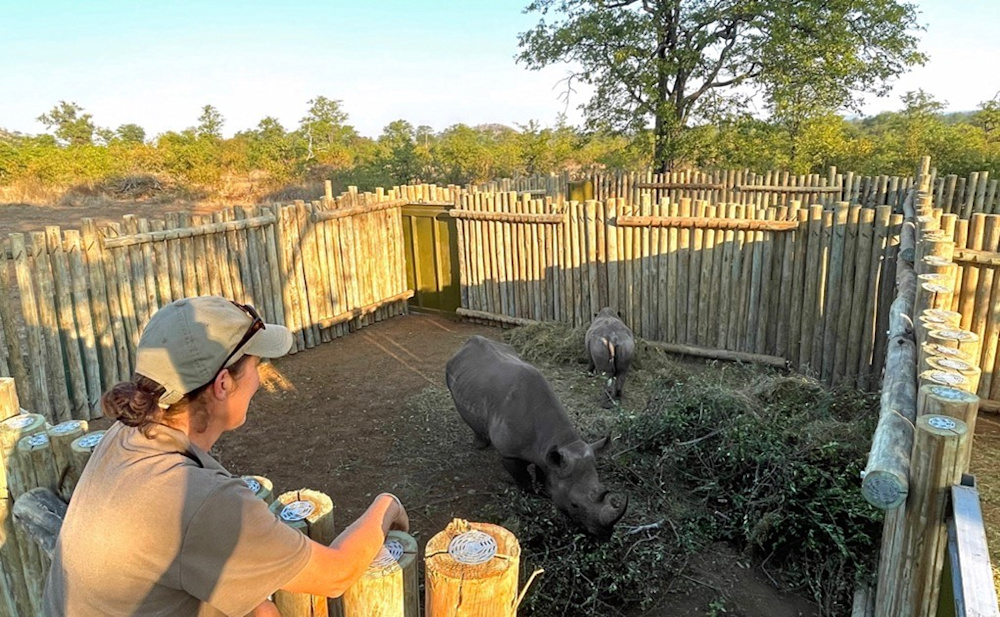August 2021
Reintroduction of black rhinos to Zimbabwe’s Gonarezhou National Park
Share:
Reintroduction of black rhinos to Zimbabwe’s Gonarezhou National Park
Singita’s commitment to preserve and protect large areas of African wilderness and wildlife for future generations has seen us form strategic partnerships with specific non-profit funds and trusts in Africa. These conservation partners work tirelessly to safeguard the wildlife in their respective regions, and their ongoing coordinated initiatives aim to ensure that everything possible is done to protect species that need special attention. Singita Pamushana has been The Malilangwe Trust’s ecotourism partner since 2008.
The critically endangered black rhino requires targeted conservation efforts to support its survival. The Malilangwe Trust began their black and white rhino conservation programme over 20 years ago. Thanks to their science-based management, dedicated protection and ideal habitat, the population densities of both species currently are such that they are able to supply and restock rhinos to other suitable protected areas in Africa.
This last three months marked a significant time in the conservation calendar as it saw black rhinos being reintroduced to Gonarezhou National Park, south of the Malilangwe Wildlife Reserve. This project was conducted by Gonarezhou Conservation Trust, with The Malilangwe
Trust and two other conservancies providing the founder stock of black rhinos. Preparations for this momentous occasion several years ago, with productive cross collaboration from private and public reserves and government entities.
Trust and two other conservancies providing the founder stock of black rhinos. Preparations for this momentous occasion several years ago, with productive cross collaboration from private and public reserves and government entities.
Long term vision
This translocation aims to re-establish a new viable population in a national park in Zimbabwe. Gonarezhou National Park is Zimbabwe’s second-largest national park and has suitable habitat for black rhinos. A Key 1 population is a categorisation, given by the IUCN's African Rhino Specialist Group, to identify a population that is stable, increasing and has achieved continental importance. Currently all three Key 1 populations in Zimbabwe are under private care, so there is immense national pride tied up in creating new viable populations in national parks.
A complex journey
The logistics for translocating one-tonne-plus megaherbivores are multi-faceted - from the animal selection, to capture, transition and then release. Logistically, physically and sociologically, it requires careful planning and a great depth of understanding of the species. Although any group of rhinos may be captured to form a new population, a careful selection of individuals that meet specific physical and social requirements is likely to improve the project’s success. “Knowing the age, sex, maternal bloodlines and histories greatly helps to ensure that genetic diversity is maintained in both populations, while understanding individual rhinos’ social relationships ensures emotional stability in a species that forms strong, yet selective relational bonds, a fact that is generally poorly recognised,” says Sarah Clegg, Ecologist at The Malilangwe Trust.
The strong team spirit between the private and public entities is also vital – and is key to this project’s success, with the handover period facilitated over time by the senior Malilangwe Scouts, whose in-depth knowledge of the individual rhinos is invaluable to Gonarezhou’s rangers.
Capture day at Malilangwe
When the time comes, a carefully coordinated process unfolds. On the day, the Malilangwe Scouts receive a list of the rhinos for translocation and head off in the early morning.

When a rhino is located, the veterinary team prepare darts and equipment and set off by helicopter. The helicopter pilot then steers the animals into terrain that’s accessible to the ground team’s vehicles, and once the rhino is darted the ground team comes in, checks the vitals and monitors them while a tracking device is inserted. The device is placed in the horn, which has no nerve endings or blood supply, so it is painless for the animal. Once this is complete, an injection to partially wake the rhino is administered and the animal is walked into the crate for transportation.



Readying for release
Once safely in Gonarezhou, the rhinos spend some time in purpose-built bomas to
acclimatise to their new home. The idea behind the bomas is to bring a routine of consistency and calm, so that the days leading up to the release are low-stress. This time also allows the rhinos to recover fully from their journey and the residual effects of darting and to become accustomed to any new browse species in their new habitat. “An acclimatised rhino and a calm release increases the likelihood of the animals adjusting to their new environment and ensures they transition onto a positive nutritional plane as soon as possible,” says Jennifer Conaghan, Boma Manager at The Malilangwe Trust. While the final release is of course triumphant, looking after rhinos involves great personal sacrifice and a lot of work, and is a complex and often emotional job – decades spent monitoring individual rhinos builds an and an understanding of these animals’ ecology and complex social relationships. "At the same time, it is also a very proud moment for us – the fact that we have enough rhino to be able to pass them on and help start a new population somewhere else," says Mike Ball, Head of Security at The Malilangwe Trust.
acclimatise to their new home. The idea behind the bomas is to bring a routine of consistency and calm, so that the days leading up to the release are low-stress. This time also allows the rhinos to recover fully from their journey and the residual effects of darting and to become accustomed to any new browse species in their new habitat. “An acclimatised rhino and a calm release increases the likelihood of the animals adjusting to their new environment and ensures they transition onto a positive nutritional plane as soon as possible,” says Jennifer Conaghan, Boma Manager at The Malilangwe Trust. While the final release is of course triumphant, looking after rhinos involves great personal sacrifice and a lot of work, and is a complex and often emotional job – decades spent monitoring individual rhinos builds an and an understanding of these animals’ ecology and complex social relationships. "At the same time, it is also a very proud moment for us – the fact that we have enough rhino to be able to pass them on and help start a new population somewhere else," says Mike Ball, Head of Security at The Malilangwe Trust.
Continuing conservation at The Malilangwe Trust
To make a genuine contribution to rhino conservation is a long-term commitment
that requires enormous dedication. Mark Saunders, Executive Director of The
Malilangwe Trust, commenting on the translocation says, “We want this to be a
success for the long term, and that will take a huge amount of responsibility,
but we're really excited to watch this process go through. We know we are part
of something fantastic here,”.
that requires enormous dedication. Mark Saunders, Executive Director of The
Malilangwe Trust, commenting on the translocation says, “We want this to be a
success for the long term, and that will take a huge amount of responsibility,
but we're really excited to watch this process go through. We know we are part
of something fantastic here,”.
With our team of dedicated and experienced wildlife managers, it's The Malilangwe Trust’s hope to contribute to more opportunities for endangered species like the black rhino in the future.


By Jenny Hishin
Author / Field Guide